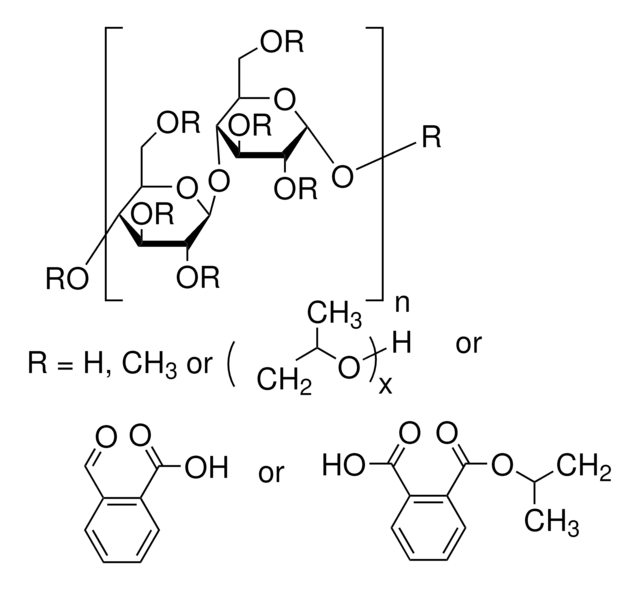1330005
USP
Hypromellose
United States Pharmacopeia (USP) Reference Standard
Synonym(s):
(Hydroxypropyl)methyl cellulose
Sign Into View Organizational & Contract Pricing
All Photos(1)
About This Item
Recommended Products
grade
pharmaceutical primary standard
API family
hypromellose
manufacturer/tradename
USP
application(s)
pharmaceutical (small molecule)
format
neat
Looking for similar products? Visit Product Comparison Guide
General description
This product is provided as delivered and specified by the issuing Pharmacopoeia. All information provided in support of this product, including SDS and any product information leaflets have been developed and issued under the Authority of the issuing Pharmacopoeia.For further information and support please go to the website of the issuing Pharmacopoeia.
Application
Hypromellose USP Reference standard, intended for use in specified quality tests and assays as specified in the USP compendia. Also, for use with USP monographs such as Hypromellose Ophthalmic Solution
Thickener for aqueous and non-aqueous systems, clear films with grease resistance, binders, lubricants, steric stabilizer and water retention aid.
Features and Benefits
Dissolves in water, undergoes reversible gelation upon heating, non-ionic, does not complex with ionic species and is surface active and enzyme resistant. Solutions are pseudoplastic.
Analysis Note
These products are for test and assay use only. They are not meant for administration to humans or animals and cannot be used to diagnose, treat, or cure diseases of any kind.
Other Notes
Sales restrictions may apply.
related product
Storage Class Code
11 - Combustible Solids
WGK
WGK 1
Flash Point(F)
Not applicable
Flash Point(C)
Not applicable
Certificates of Analysis (COA)
Search for Certificates of Analysis (COA) by entering the products Lot/Batch Number. Lot and Batch Numbers can be found on a product’s label following the words ‘Lot’ or ‘Batch’.
Already Own This Product?
Find documentation for the products that you have recently purchased in the Document Library.
Customers Also Viewed
Michelle Lay Teng Ang et al.
Infection and immunity, 82(5), 1850-1859 (2014-02-26)
Tuberculosis remains a major worldwide epidemic because of its sole etiological agent, Mycobacterium tuberculosis. Ethionamide (ETH) is one of the major antitubercular drugs used to treat infections with multidrug-resistant M. tuberculosis strains. ETH is a prodrug that requires activation within
Samuel A Jensen et al.
Proceedings of the National Academy of Sciences of the United States of America, 111(15), 5682-5687 (2014-04-08)
Therapy resistance is a major limitation to the successful treatment of cancer. Here, we identify Bcl2-like 13 (Bcl2L13), an atypical member of the Bcl-2 family, as a therapy susceptibility gene with elevated expression in solid and blood cancers, including glioblastoma
Jo Hoeser et al.
FEBS letters, 588(9), 1537-1541 (2014-04-01)
Cytochrome bd ubiquinol oxidase uses the electron transport from ubiquinol to oxygen to establish a proton gradient across the membrane. The enzyme complex consists of subunits CydA and B and contains two b- and one d-type hemes as cofactors. Recently
Qichen Jiang et al.
Ecotoxicology and environmental safety, 104, 423-428 (2014-04-01)
We evaluated the effect of acute exposure to nitrite on expression of antioxidant and metabolic enzyme genes in gill tissue of advanced juvenile Cherax quadricarinatus. A 48h nitrite exposure was conducted, using four test concentrations (NO2-N=0.5, 1, 1.5 and 2mg
Somayeh Bahrami et al.
Veterinary parasitology, 203(1-2), 43-50 (2014-03-19)
Fasciola gigantica is a parasitic helminth that predominantly infects the liver and bile ducts of cattle and causes great losses of cattle production in the southwestern regions of Iran. The purpose of the present study was to find out the
Our team of scientists has experience in all areas of research including Life Science, Material Science, Chemical Synthesis, Chromatography, Analytical and many others.
Contact Technical Service





